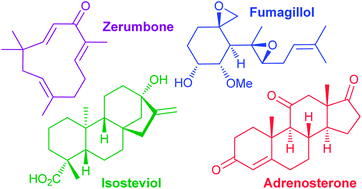Natural products as starting points for the synthesis of complex and diverse compounds
Abstract
Covering: up to 2013
Natural products and their derivatives are used as treatments for numerous diseases. Many of these compounds are structurally complex, possessing a high percentage of sp3 hybridized carbons and multiple stereogenic centers. Due to the difficulties associated with the isolation of large numbers of novel natural products, lead discovery efforts over the last two decades have shifted toward the screening of less structurally complex synthetic compounds. While there have been many success stories from these campaigns, the modulation of certain biological targets (e.g. protein–protein interactions) and disease areas (e.g. antibacterials) often require complex molecules. Thus, there is considerable interest in the development of strategies to construct large collections of compounds that mimic the complexity of natural products. Several of these strategies focus on the conversion of simple starting materials to value-added products and have been reviewed elsewhere. Herein we review the use of natural products as starting points for the generation of complex compounds, discussing both early ad hoc efforts and a more recent systematization of this approach.


 Please wait while we load your content...
Please wait while we load your content...